Hospitality Management in New York City: Policies, Perspectives and Butler's Curve
22 Pages6303 Words367 Views
Added on 2023-06-07
About This Document
This article discusses the policies, environmental, economic and socio-cultural perspectives of hospitality management in New York City. It explores Butler's Curve and its stages of development, including exploration, involvement, development, consolidation, stagnation and decline or rejuvenation. Recommendations are provided for improving policies and engaging the community and stakeholders.
Hospitality Management in New York City: Policies, Perspectives and Butler's Curve
Added on 2023-06-07
ShareRelated Documents
Running Head: HOSPITALITY MANAGEMENT 1
Hospitality Management
Hospitality Management
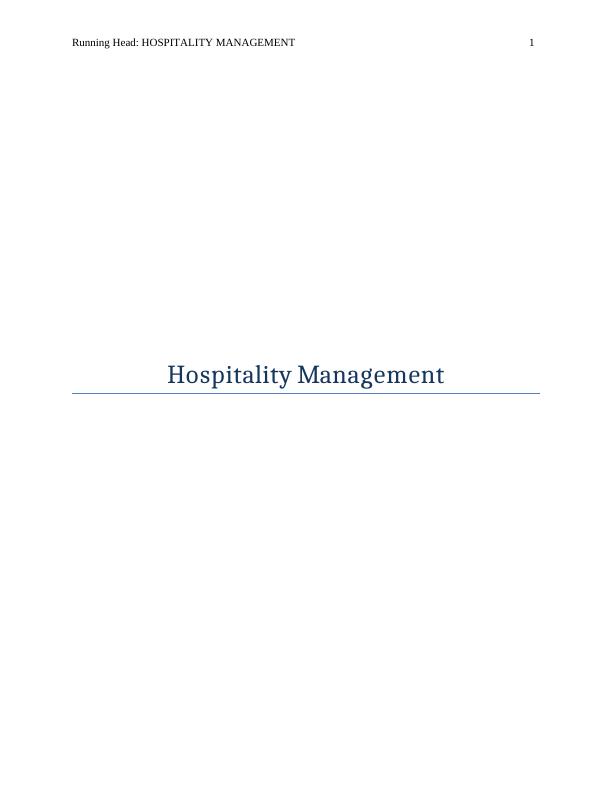
HOSPITALITY MANAGEMENT 2
Table of Contents
Part A...........................................................................................................................................................3
Introduction.................................................................................................................................................3
About the Policies........................................................................................................................................4
Environmental Perspective......................................................................................................................5
Economic Perspective..............................................................................................................................5
Socio-cultural Perspective.......................................................................................................................7
About Theory (Butler’s Curve).....................................................................................................................8
Exploration..............................................................................................................................................9
Involvement.............................................................................................................................................9
Development...........................................................................................................................................9
Consolidation...........................................................................................................................................9
Stagnation...............................................................................................................................................9
Decline or Rejuvenation........................................................................................................................10
Recommendations.....................................................................................................................................10
Policies...................................................................................................................................................10
Agenda..................................................................................................................................................10
Conclusion.................................................................................................................................................11
Part B.........................................................................................................................................................12
Introduction...............................................................................................................................................12
History of Building.................................................................................................................................12
Current Function....................................................................................................................................12
Critical Analysis of Impact on its surroundings..........................................................................................13
Social Impact.........................................................................................................................................13
Economic Impact...................................................................................................................................14
Theory (Gunn’s Theory).............................................................................................................................15
A Tourist or Human Element.................................................................................................................15
A Nucleus or Central Element................................................................................................................16
A Marker or Informative Element..........................................................................................................16
Conclusion (Future of Historic Building)....................................................................................................17
References.................................................................................................................................................18
Table of Contents
Part A...........................................................................................................................................................3
Introduction.................................................................................................................................................3
About the Policies........................................................................................................................................4
Environmental Perspective......................................................................................................................5
Economic Perspective..............................................................................................................................5
Socio-cultural Perspective.......................................................................................................................7
About Theory (Butler’s Curve).....................................................................................................................8
Exploration..............................................................................................................................................9
Involvement.............................................................................................................................................9
Development...........................................................................................................................................9
Consolidation...........................................................................................................................................9
Stagnation...............................................................................................................................................9
Decline or Rejuvenation........................................................................................................................10
Recommendations.....................................................................................................................................10
Policies...................................................................................................................................................10
Agenda..................................................................................................................................................10
Conclusion.................................................................................................................................................11
Part B.........................................................................................................................................................12
Introduction...............................................................................................................................................12
History of Building.................................................................................................................................12
Current Function....................................................................................................................................12
Critical Analysis of Impact on its surroundings..........................................................................................13
Social Impact.........................................................................................................................................13
Economic Impact...................................................................................................................................14
Theory (Gunn’s Theory).............................................................................................................................15
A Tourist or Human Element.................................................................................................................15
A Nucleus or Central Element................................................................................................................16
A Marker or Informative Element..........................................................................................................16
Conclusion (Future of Historic Building)....................................................................................................17
References.................................................................................................................................................18
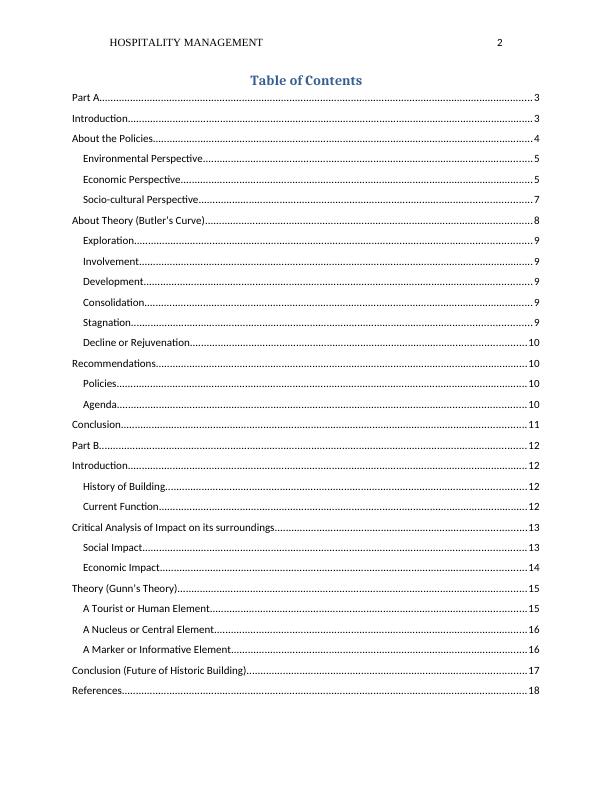
HOSPITALITY MANAGEMENT 3
Part A
Introduction
Nowadays, tourism and leisure places are having very much priority everyday across the world.
As the finance and people are getting mobile in tourism and leisure industry, strategic planning is
becoming very important for the development of tourist places. Today, tourism is one of the
major wheels of country’s economy. The countries are shifting from traditional processes like
firms, factories and industry; they are giving preferences to non-industrial places and activities.
This is the reason that tourism and leisure is considered as the most significant sector. For this
discussion, New York City is chosen as a tourist place. New York City (The City of New York)
is the most populous city in the United States of America. This is known as global power city
that can be described exclusively as financial, media and cultural capital of the world. It
exercises a huge impact on entertainment, research, education, commerce, technology, art,
tourism, sports, fashion and politics. It is the part of UN WTO (United Nations World Tourism
Organization) (Maitland and Newman, 2014).
New York City is important in the development of American tourism as it is one of the greatest
cities all over the world. It is always a whirlwind of activity with popular places at every turn. In
the year 2017, this city received an 8th successive yearly record of around 62.8 million tourists.
The major reason behind this is that there are various famous destinations like Statue of Liberty,
Empire State Building, Coney Island, Times Square, Central Park, Broadway theater
productions, Ellis Island, the Financial District, sports stadiums, museums, premium shopping
along Madison and Fifth Avenues and different events like Tribeca Film Festival and
performances in Central Park at Delacorte Theater and Summer-stage (Law, 2018). The
economy of this county is highly dependent on the travel and tourism activities. It is under the
top five tourist destinations all over the world.
Part A
Introduction
Nowadays, tourism and leisure places are having very much priority everyday across the world.
As the finance and people are getting mobile in tourism and leisure industry, strategic planning is
becoming very important for the development of tourist places. Today, tourism is one of the
major wheels of country’s economy. The countries are shifting from traditional processes like
firms, factories and industry; they are giving preferences to non-industrial places and activities.
This is the reason that tourism and leisure is considered as the most significant sector. For this
discussion, New York City is chosen as a tourist place. New York City (The City of New York)
is the most populous city in the United States of America. This is known as global power city
that can be described exclusively as financial, media and cultural capital of the world. It
exercises a huge impact on entertainment, research, education, commerce, technology, art,
tourism, sports, fashion and politics. It is the part of UN WTO (United Nations World Tourism
Organization) (Maitland and Newman, 2014).
New York City is important in the development of American tourism as it is one of the greatest
cities all over the world. It is always a whirlwind of activity with popular places at every turn. In
the year 2017, this city received an 8th successive yearly record of around 62.8 million tourists.
The major reason behind this is that there are various famous destinations like Statue of Liberty,
Empire State Building, Coney Island, Times Square, Central Park, Broadway theater
productions, Ellis Island, the Financial District, sports stadiums, museums, premium shopping
along Madison and Fifth Avenues and different events like Tribeca Film Festival and
performances in Central Park at Delacorte Theater and Summer-stage (Law, 2018). The
economy of this county is highly dependent on the travel and tourism activities. It is under the
top five tourist destinations all over the world.
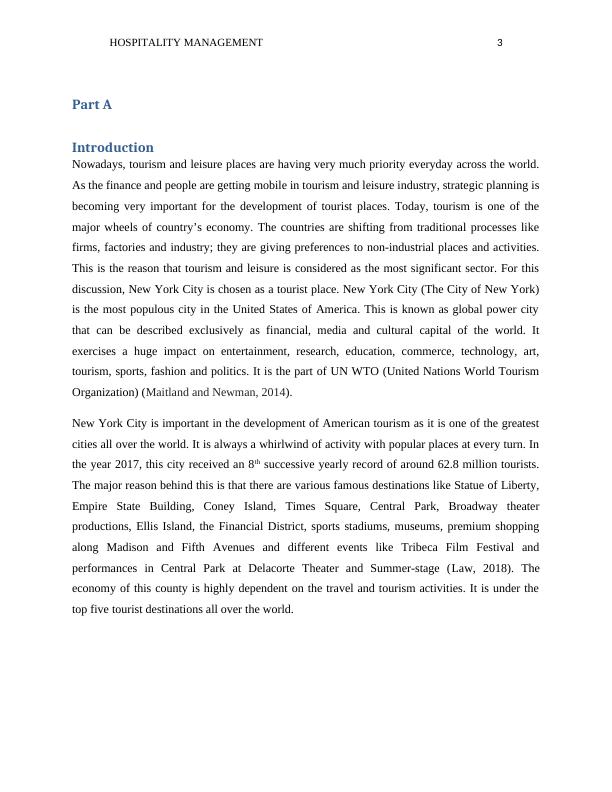
HOSPITALITY MANAGEMENT 4
Figure 1: 3 Year Forecast of Top 5 Tourist Destinations
(Source: Maitland and Newman, 2014)
It is a growing and substantial component of this state’s economy in US. In the city, an
international visitor spends about $1600 per trip in comparison to just $400 spent by the
Americans. Recently, tourism spending in New York has increased by 5.4% to $62.5 billion (The
Weissman Centre for International Business, 2018). The data shows that New York’s economy is
highly dependent on travel and tourism. The current scene of state’s tourism is that it has
generated nations for foreign visitors to New York City were Brazil, United Kingdom, China,
Canada, Australia, Germany, France, Mexico, Japan and Spain. It has social, economic and
environmental impact in the area.
About the Policies
In New York City, there is a significant growth in the travel and tourism as there is an increase in
the number of visitors from international countries. This state is continuously attracting travellers
from United States and across the world. As a foundation of New York’s economy, tourism
directs assists over 914,000 jobs and produces billions of dollars spending across the county
every year. The UNWTO has created and implemented various policies and programs to sustain
and grow tourism in the county (Jarvis, Stoeckl and Liu, 2016). These policies can be divided in
three perspectives which are given below:
Figure 1: 3 Year Forecast of Top 5 Tourist Destinations
(Source: Maitland and Newman, 2014)
It is a growing and substantial component of this state’s economy in US. In the city, an
international visitor spends about $1600 per trip in comparison to just $400 spent by the
Americans. Recently, tourism spending in New York has increased by 5.4% to $62.5 billion (The
Weissman Centre for International Business, 2018). The data shows that New York’s economy is
highly dependent on travel and tourism. The current scene of state’s tourism is that it has
generated nations for foreign visitors to New York City were Brazil, United Kingdom, China,
Canada, Australia, Germany, France, Mexico, Japan and Spain. It has social, economic and
environmental impact in the area.
About the Policies
In New York City, there is a significant growth in the travel and tourism as there is an increase in
the number of visitors from international countries. This state is continuously attracting travellers
from United States and across the world. As a foundation of New York’s economy, tourism
directs assists over 914,000 jobs and produces billions of dollars spending across the county
every year. The UNWTO has created and implemented various policies and programs to sustain
and grow tourism in the county (Jarvis, Stoeckl and Liu, 2016). These policies can be divided in
three perspectives which are given below:
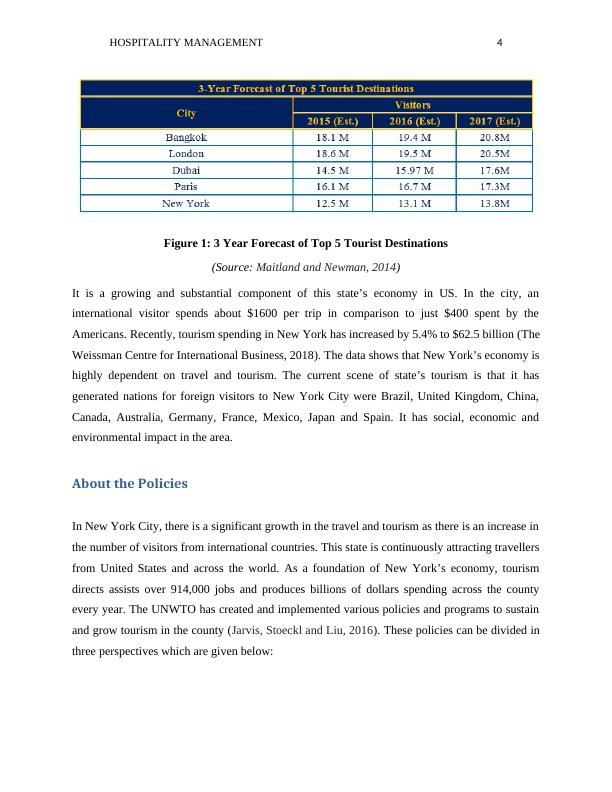
HOSPITALITY MANAGEMENT 5
Environmental Perspective
In United States, ecotourism activities may be subject to the policies and regulations at different
levels of government depending on the status and location. In New York, the management and
land utilization activities are controlled at state level. The regulatory authority in the state has
imposed various local and state policies related to ecotourism. These policies are implemented in
the form of code of conduct, best practices, environmental protection measures, zoning, entrance
fees, fines for inappropriate disposal of wastage and effective utilization of eco-tourism facilities.
In this state, the regulations generally seek to reduce the environmental effects from the presence
of tourists in area like foot traffic, noise, trampling, and collection of animal and plant materials.
The country has introduced its environmental policy in the year 1960 (Alonso and Liu, 2013).
UNWTO has come with different acts and regulations like Clean Water Act, Comprehensive
Environmental Response, Compensation and Liability Act (CERCLA), Endangered Species Act
etc. One of the major policies is CERCLA that was passed by Congress in the year 1980. It is the
policy that is aimed to reduce the hazardous pollutants at uncontrolled waste sites. This initiates
different clean-up projects at tourism destinations in New York City and require the responsible
tourists to pay for costs of cleaning. This policy is very effective in the city as it improves and
protects the environment and natural resources. It has various authorities which impact all the
activities consisting of eco-tourism operations, waters, private and public lands of US
concessions (Adriana, 2009). The authority is able to manage and protect tourism destinations
like parks, national forests, wildlife refuges etc. Same as this policy, another NTO like European
Travel Commission has also introduced a policy that includes highest environmental standards
that assists green the economy, protect the natural resources and preserve the quality and health
of people’s lives.
Economic Perspective
Travel and tourism operations constitute a significant part of the economy of New York State.
National Travel and Tourism Office in US is the major source of economic data on foreign
visitation to New York. It provides policies to assist the tourism and travel exports in the state
(Mowforth and Munt, 2015).
Environmental Perspective
In United States, ecotourism activities may be subject to the policies and regulations at different
levels of government depending on the status and location. In New York, the management and
land utilization activities are controlled at state level. The regulatory authority in the state has
imposed various local and state policies related to ecotourism. These policies are implemented in
the form of code of conduct, best practices, environmental protection measures, zoning, entrance
fees, fines for inappropriate disposal of wastage and effective utilization of eco-tourism facilities.
In this state, the regulations generally seek to reduce the environmental effects from the presence
of tourists in area like foot traffic, noise, trampling, and collection of animal and plant materials.
The country has introduced its environmental policy in the year 1960 (Alonso and Liu, 2013).
UNWTO has come with different acts and regulations like Clean Water Act, Comprehensive
Environmental Response, Compensation and Liability Act (CERCLA), Endangered Species Act
etc. One of the major policies is CERCLA that was passed by Congress in the year 1980. It is the
policy that is aimed to reduce the hazardous pollutants at uncontrolled waste sites. This initiates
different clean-up projects at tourism destinations in New York City and require the responsible
tourists to pay for costs of cleaning. This policy is very effective in the city as it improves and
protects the environment and natural resources. It has various authorities which impact all the
activities consisting of eco-tourism operations, waters, private and public lands of US
concessions (Adriana, 2009). The authority is able to manage and protect tourism destinations
like parks, national forests, wildlife refuges etc. Same as this policy, another NTO like European
Travel Commission has also introduced a policy that includes highest environmental standards
that assists green the economy, protect the natural resources and preserve the quality and health
of people’s lives.
Economic Perspective
Travel and tourism operations constitute a significant part of the economy of New York State.
National Travel and Tourism Office in US is the major source of economic data on foreign
visitation to New York. It provides policies to assist the tourism and travel exports in the state
(Mowforth and Munt, 2015).
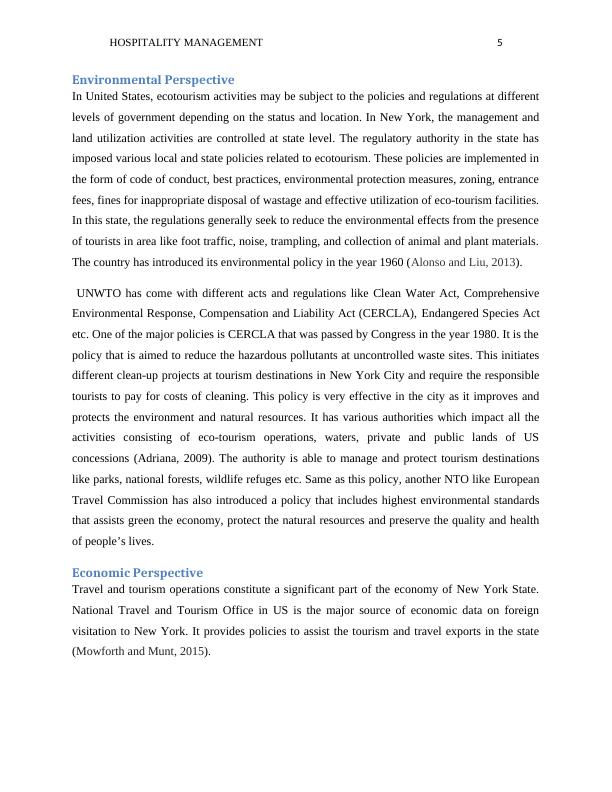
HOSPITALITY MANAGEMENT 6
Figure 2: Tourism spending on New York in 2017
(Source: The Weissman Centre for International Business, 2018)
Under economic perspective, the government has introduced fiscal policy that is related to
spending, taxation, stimulus measures etc. In New York, it impacts the tourism investment and
customer spending in travel and tourism activities. Moreover, monetary policy has a significant
impact on the exchange rates that in turn affects the demand of foreign travellers and exchange
earnings from tourism activities. The economic policies of this county supports value added
pricing and heavy discounting that enhances tourism and hospitality to New York. The
effectiveness of this policy can be analyzed by looking at the economic effects of tourism. Last
year, tourists spending generated $43 billion including induced and indirect effects. The city has
sustained 383,385 jobs by tourism and hospitality activities with the total income of $33.1 billion
(Pereira, 2018).
Figure 2: Tourism spending on New York in 2017
(Source: The Weissman Centre for International Business, 2018)
Under economic perspective, the government has introduced fiscal policy that is related to
spending, taxation, stimulus measures etc. In New York, it impacts the tourism investment and
customer spending in travel and tourism activities. Moreover, monetary policy has a significant
impact on the exchange rates that in turn affects the demand of foreign travellers and exchange
earnings from tourism activities. The economic policies of this county supports value added
pricing and heavy discounting that enhances tourism and hospitality to New York. The
effectiveness of this policy can be analyzed by looking at the economic effects of tourism. Last
year, tourists spending generated $43 billion including induced and indirect effects. The city has
sustained 383,385 jobs by tourism and hospitality activities with the total income of $33.1 billion
(Pereira, 2018).
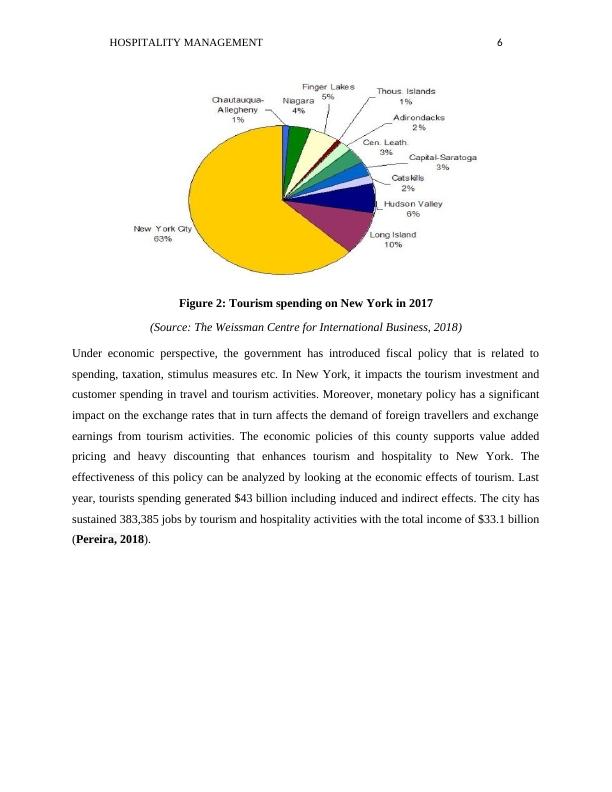
End of preview
Want to access all the pages? Upload your documents or become a member.
Related Documents
Hospitality Management: Policies and Perspectives in New York Citylg...
|15
|3349
|459
Introduction to Tourism and Hospitalitylg...
|4
|450
|149
THB 1104 - Local Tourism Attraction of Sydney, Australia The Bondi Beachlg...
|5
|441
|37
Contemporary Hotel and Tourism Issueslg...
|15
|3139
|453
Tourists Destinations in UK : Reportlg...
|15
|4015
|64
Development and Growth Tourism Industrylg...
|11
|2811
|175
